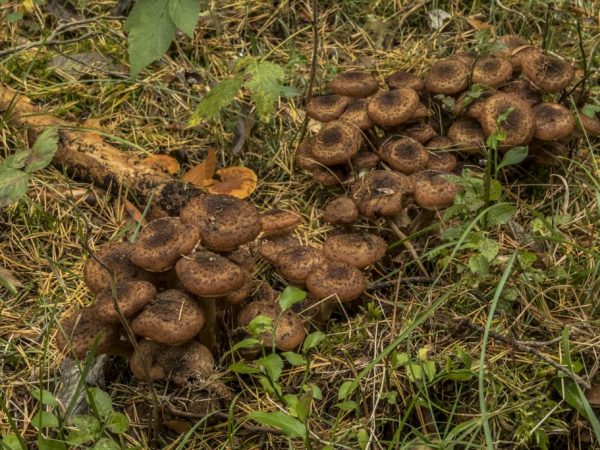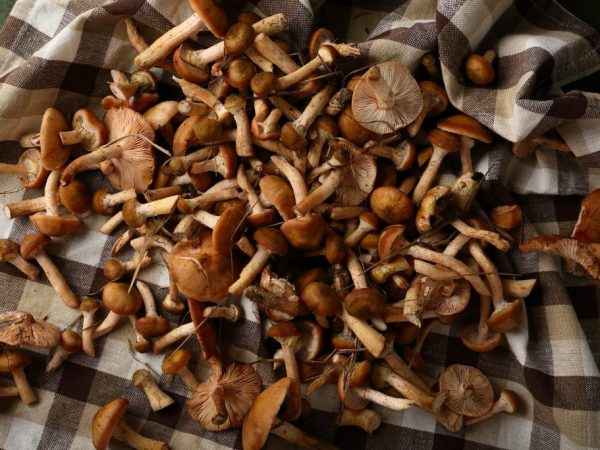Dark mushrooms
Dark honey agaric is perhaps, if I may say so, the most recognizable representative of honey agaric, whose fruiting bodies are usually located in a semicircle near the stumps. Dark mushrooms, or as they can still be called - ground mushrooms, or armillaria, which translated from Latin means "bracelet" have such a name, due to, firstly, their color, and secondly, their location near the stumps, which really resembles are the components of the bracelet.

Dark mushrooms
The appearance of the mushroom
The dark honey fungus has a long brown-yellow stem with a smooth surface. In their appearance, dark mushrooms are very reminiscent of autumn mushrooms, which are characterized by a "skirt" in the middle of the leg in the form of a filmy and yellow-colored ring - the remainder of a private velum (bedspread) and a hat - smoother and having a honey-yellow color. The color of the mushroom depends on the following factors:
- a place;
- humidity;
- shine;
- a species of woody plant, from which a stump remained.
Near the old and rotten stump, there will be mushrooms with darker caps.
Irina Selyutina (Biologist):
For dark mushrooms, or mushrooms of hard spruce, a convex or flat hat is characteristic, painted in rather dark (reddish-yellow, brownish) tones and covered with darker scales. In the center, the cap has a more intense - dark color. Fringed white remnants of the bedspread are located along the edge of the cap. The plates are sparse; as the fungus grows, they change their color from whitish-yellow to more intense. The leg has a well-defined fringed ring and has a thickening at its base.
The mycelium of the fungus is located underground, above which only spore-bearing fruiting bodies rise. It is believed that these largest organisms in the world are very dangerous for forests, however, mainly for conifers and are capable of causing seemingly unreasonable death of trees.
By the way. The largest mushroom is the dark honey fungus growing in the state of Oregon (USA). Its mycelium covers an area of more than 880 hectares and is about 2400 years old.
Mushroom species
Dark mushrooms are divided into several types:
- Summer honey mushroom: an edible mushroom that usually grows near deciduous trees. Summer mushrooms are not found singly, they are located only in a large group. It has a brownish-red cap and dark-colored stem.
- Autumn honey agaric: an edible type of mushroom, but in appearance it can easily be confused with a poisonous gallery. When collecting autumn mushrooms, you should always pay attention to the color of the pulp at the bottom of the cap - it should not be lighter than the leg. The bottom of the cap is black.
- Winter honey mushroom, or flammulina velvety-footed: this amazing species has an interesting feature - its fruiting bodies are able to survive at subzero temperatures. You can collect them in winter, and in this case it is almost impossible to confuse me with poisonous twins. They are great for pickling, pickling, soups and sauces. But since in the process of cooking they become slimy (and not everyone likes it), they are used by their lovers.
- Meadow honey fungus, or clove mushroom: this species is found in clearings, in the depths of the forest, near small stumps or near deciduous trees. It is worth paying attention to the leg - it has a dark, brownish-red color. Unlike the usual dark, this species does not grow in arched, but in straight rows. By the way. Meadow honey agaric is often confused with a poisonous species of whitish talker.
When collecting mushrooms, you should carefully look at the color of the cap and the lower (supporting plate of the hymenophore) side. The red color of the cap should scare away mushroom pickers. The honey fungus is dark with a dark color of the cap with a fairly light hymenophore.
Beneficial features
Dark honey is a popular dish in any kitchen. They are also often used for weight loss, as they have a small amount of calories. On average, calculated per 100 g of product, the calorie content is 22 kcal.
Dark mushroom contains vitamins, useful amino acids, a large amount of fiber:
- vitamin C - more than 10 mg;
- riboflavin - 0.43 mg;
- niacin - 10 mg;
- vitamin E - 0.71 mg.
The amount of micro- and macroelements present in them "rolls over" when compared with the norm necessary for the normal life of the human body:
- Fe (daily requirement - 4.3 mg) - 0.82 mg;
- K (daily requirement - 16.5 mg) - 410 mg;
- Ca (daily requirement - 0.51 mg) - 5.0 mg;
- Mg (daily requirement - 5.1 mg) - 21 mg;
- Na (daily requirement - 0.41 mg) - 5.0 mg;
- P (daily requirement - 5.65 mg) - 46 mg.
In grams per 0.1 kg of product, the amount of organic matter corresponds to:
- proteins - more than 2 g;
- fats (saturated and polyunsaturated) - 0.3 g;
- fiber or dietary fiber - about 3 g;
- simple carbohydrates - more than 0.25 g.
Contraindications

Children under 12 cannot eat mushrooms
Despite the beneficial properties of these mushrooms, they have some contraindications for use.
Irina Selyutina (Biologist):
Dark mushrooms, like all representatives of this group (mushrooms) are conditionally edible mushrooms. This means the following:
- undercooked mushrooms can cause kidney and liver problems;
- it is necessary to strictly observe sanitary and hygienic standards during conservation, so that even the smallest particles of dirt do not get into the banks - they can provoke the development of botulism pathogens in favorable conditions and, as a result, cause human death.
They can harm children under the age of 12, as they do not have enzymes in their bodies that mushrooms can digest.
People with problems of the gastrointestinal tract should also use dark honey with caution. During pregnancy and lactation, it is worth consulting a specialist before eating mushrooms, since during this period the body's perception of certain foods is complicated.
It is also important to limit or even exclude honey agarics from the diet of the following categories of people suffering from:
- hypertension, because salted mushrooms cause fluid retention in the body;
- diseases of the joints, tk. honey agarics are characterized by a high content of purine substances.
Application
Dark mushrooms are used in both cooking and medicine. When eating them, you need to be careful to carefully study the recipe so as not to harm your body. There is a huge list of recipes in which it is permissible to use dark mushrooms.
In cooking
When preparing honey mushrooms, it is required to take into account that the leg of the mushroom is tough and not always suitable for consumption. Therefore, they use only a honey agaric cap. After harvesting, the mushrooms are soaked in water for 30-40 minutes, after which they must be thoroughly washed and the leg must be separated from the cap. After that, they must be boiled for 10 minutes and the broth is drained, along with which natural resins and the bitterness inherent in mushrooms will be removed. Then you can start cooking.
Honey mushrooms are fried, boiled, pickled and salted. The mushrooms are also kept frozen until next time they are cooked.
Undercooked mushrooms can be dangerous: there is a risk of poisoning the body after eating. It is best to cook them for as long as possible.
In medicine
Dark mushrooms can be used in medicine as an antiseptic. Do not self-medicate, as an improperly prepared medicinal product from mushrooms will easily cause poisoning and intoxication of the body.
Growing methods
There are several ways to grow mushrooms on your own:
- in the substrate;
- on stumps;
- in banks.
The budget options are the second and third.
However, when growing honey agarics, it is important to prevent the transfer of the mycelium to nearby growing trees.
Conclusion
When collecting mushrooms, you should definitely take into account their place of growth and features of their appearance. Cooking dark mushrooms will not take much time, but it is worth making sure that the mushrooms are not raw, as this can lead to poisoning.



